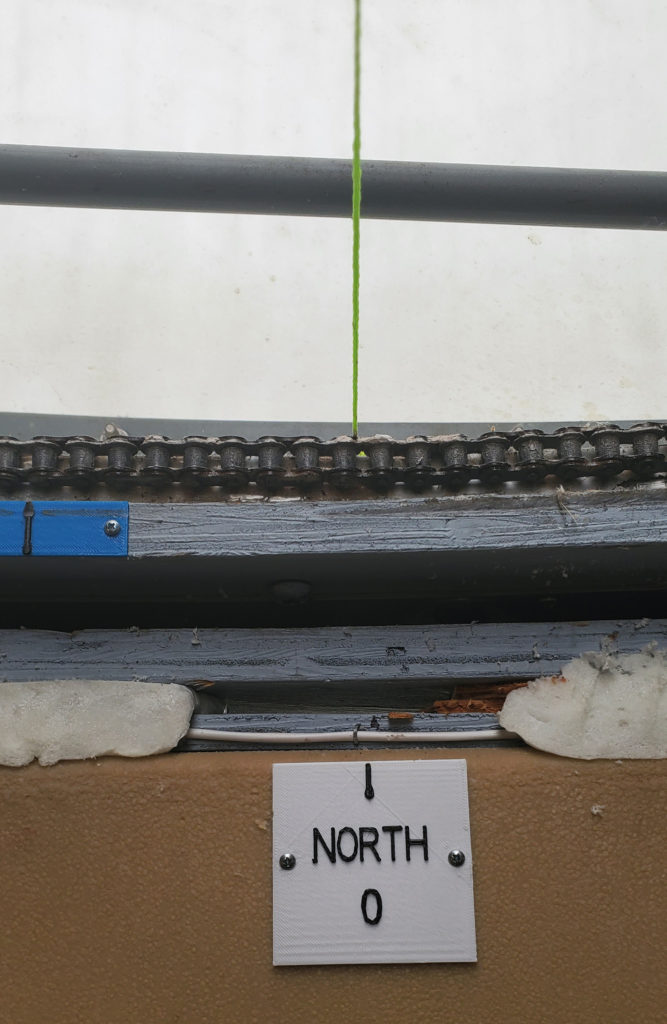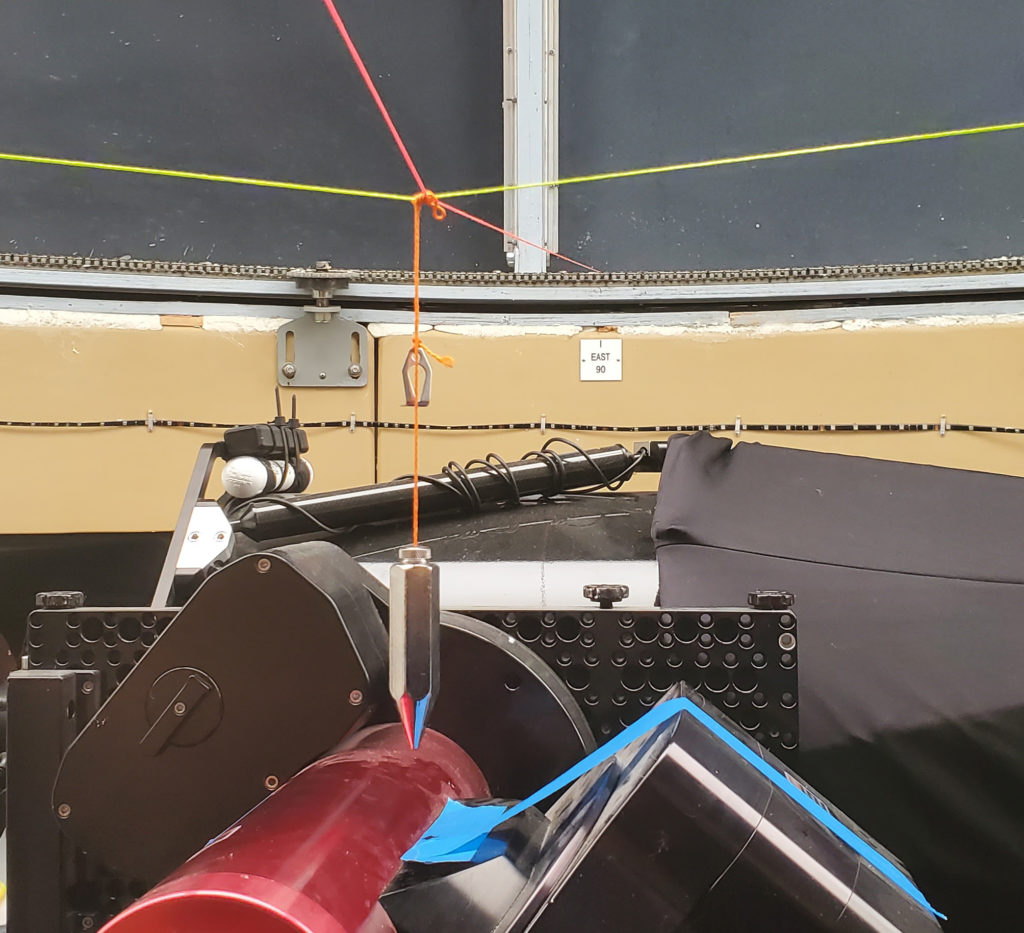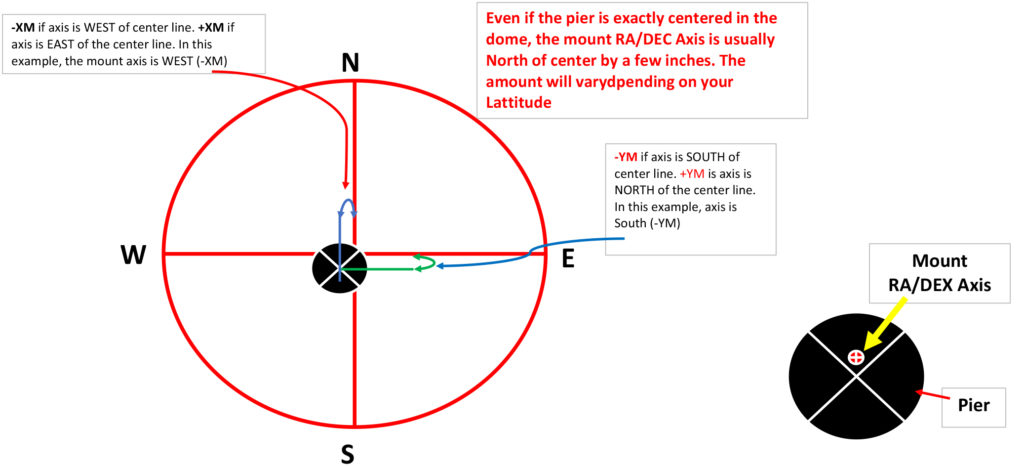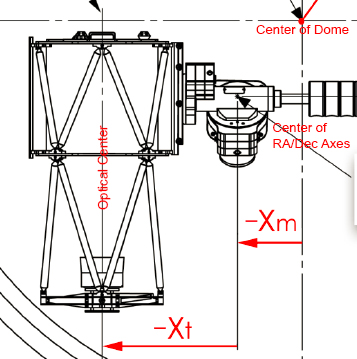Introduction
The SkyX software allows for the configuration of an observatory dome to sync the position of the telescope mount and dome slot where the telescope has an unobstructed view of the sky.
This document assumes that you have the dome connected to TheSkyX, and you desire to determine the proper parameters for flawless operation. There are extensive mathematical formulae involved behind the scenes which this document will not cover. This document will attempt to simplify the process of determining the proper values to use.
Taking the Measurements
It would be best first determine the positions of north, south, east, and west inside the observatory. Essentially your dome is a compass, so it is good to know your directions while inside. I did this by making up placards to show “North 0°”, “West 270°”, “South 180°” and “East 90°”. I wanted permanent placards, so I printed them on my 3D printer. I also made a simple “line” placard placed at the center of the slot opening to gauge the direction of the slot opening.
Start by determining true north, using a compass and adjusting for magnetic declination for your area. Later we will use another method to ensure the enter of the slot is at Polaris. Use software such as Dome Commander to move the dome to each azimuth setting (0,90,180 and 270) and place the directional placard at that position (see figure 1). If you find that you need to adjust the true north position of your dome later, you will need to move the placards to their correct positions.

Determine the center of the dome slot and place the gauge placard there. While doing this, measure the width of the slot (preferably in millimeters) and jot this number down as “Slot Width”. The center will be at half of this number. You will need this to properly find the “home position” for your dome slot. In my case, the home position should be true north.
At this point, position the scope where the RA/Dec axis is level and the scope is parallel to the ground.
Obtain some string that can run from side to side of the dome. I used colored string to distinguish each of north/south and east/west line.
Install a nail or picture hanger at each north, east, south and west coordinates on the dome ring inset from the dome chain. These will be the anchors for each length of string used (See Figure 2).
Run a string from the north to the south. This should intersect the mount.
Run a second string from the east to the west. This string should parallel your counterbalance weight axis shaft.
Place a plumb bob at the point where the two strings intersect. The center of the dome sphere is where the plumb bob is pointing.

Now you are ready to take the measurements.
Preparing for measurements
On a notepad, write down rows for the following:
- Slot width
- Dome radius
- The offset of Mount from Dome
a. Xm
b. Ym
c. Zm - The offset of Telescope from Mount
a. Xt
Taking the measurements
Once again, take all measurements in millimeters. This can give you the most precise measurements when using them in TheSkyX. TheSkyX does not care what unit of measure you use if all your measurements are the same unit of measure. If you use “inches” as your unit of measure, you will need to convert them to decimal values and carry all measurements to the same number of digits (i.e. 12 15/16” would be 12.9375. All measurements would be multiplied by the same factor of 10 to retain the desired precision, or as in this case multiplying by 10,000 will produce 129375.
You should already have the “Slot Width” measurements from finding the center of the slot. Write this number down here.
You can measure from the dome’s edge to the center of the observatory for the dome radius. In my case, I have a Skyshed PODMAX with the Kendrick Astro Instruments’ CRM-114 control unit. It measures the circumference of the dome by the number of “steps”, with 4 steps equaling an inch. Since my dome measures 1732 steps, this becomes a circumference of 433 inches or 11,000 millimeters. The radius, therefore, is 1,750 millimeters (r=c/2π). Jot down this number as “Dome Radius”.
Borrowing from TheSkyX documentation, Xm is the distance from the north/south centerline of the center of the dome sphere to the intersection of the RA and Dec axes (See Figure 3). If it is a westward offset of the RA from the dome center, make this number negative; otherwise, make it positive. Jot this value down as “Xm”.

Next, measure the distance from the east-west centerline to the intersection of the RA and Dec axes. If this value is a southward offset of the mount from the dome center, then make this number negative; otherwise, make it positive. This will be the value for Ym. (See Figure 3).
Next measure the vertical distance from the center of the dome sphere to the intersection of the RA and Dec axes. You will need to make sure the string is not sagging from the plumb bob. If the RA/Dec axes are below the edge of the slot, make this number negative; otherwise, make it positive. Write this value down as Zm. (See Figure 2 measuring from the dot on the tape to the intersection of the RA/Dec axes).
For the value of Xt, measure from the telescope’s optical center to the center of the RA/Dec axes. If you have a second telescope piggybacked, measure from the optical center of the second telescope to the intersection of the RA/Dec axes. You will need to save two profiles in TheSkyX, one for each telescope. Alternatively, you can set the measurement to be in the center of the two optical centers if your slot is wide enough for both scopes to view through. (See Figure 4).

Affix the home sensor so that the line representing the center of the slot opening will land at 0° north. If your dome properly homes at this location and your markers for east, west, and south are correctly placed, you should be able to direct your dome to each of the cardinal directions (0°, 90°, 180°, and 270°) and have the center of the slot opening line up directly with each of those directions.
Follow the instructions in TheSkyX Pro User Guide from Bisque and you should have a perfectly operating dome and mount.